
Pride Month Marketing: Best Practices & Examples [2025]
Every June, brands launch Pride Month campaigns to support the LGBTQIA+ community. While it’s a great initiative to show inclusivity, many of these efforts are seen as surface-level or inconsistent with a brand’s actions the rest of the year.
As a result, some companies are scaling back, while others are working to show genuine, long-term support.
In this post, we’ll see what Pride Month marketing means today and how to approach it without being performative. We’ll also share examples and explore why representation should not be limited to one month.
The State of Pride Month Marketing
Pride Month is now a regular part of many marketing calendars.
But it started as an act of resistance, most notably the Stonewall uprising in 1969. Since then, Pride has grown into a global movement focusing on activism, visibility, and community.
Today, more brands take part, launching themed products and campaigns. But showing up in June isn’t enough. Consumers want to know how a brand supports the LGBTQIA+ community and why.
A rainbow logo or limited-edition item means little without real, year-round action behind it. In fact, 62% of consumers believe that launching Pride-themed products is done mostly for profit, while only 34% view it as a gesture of social good.
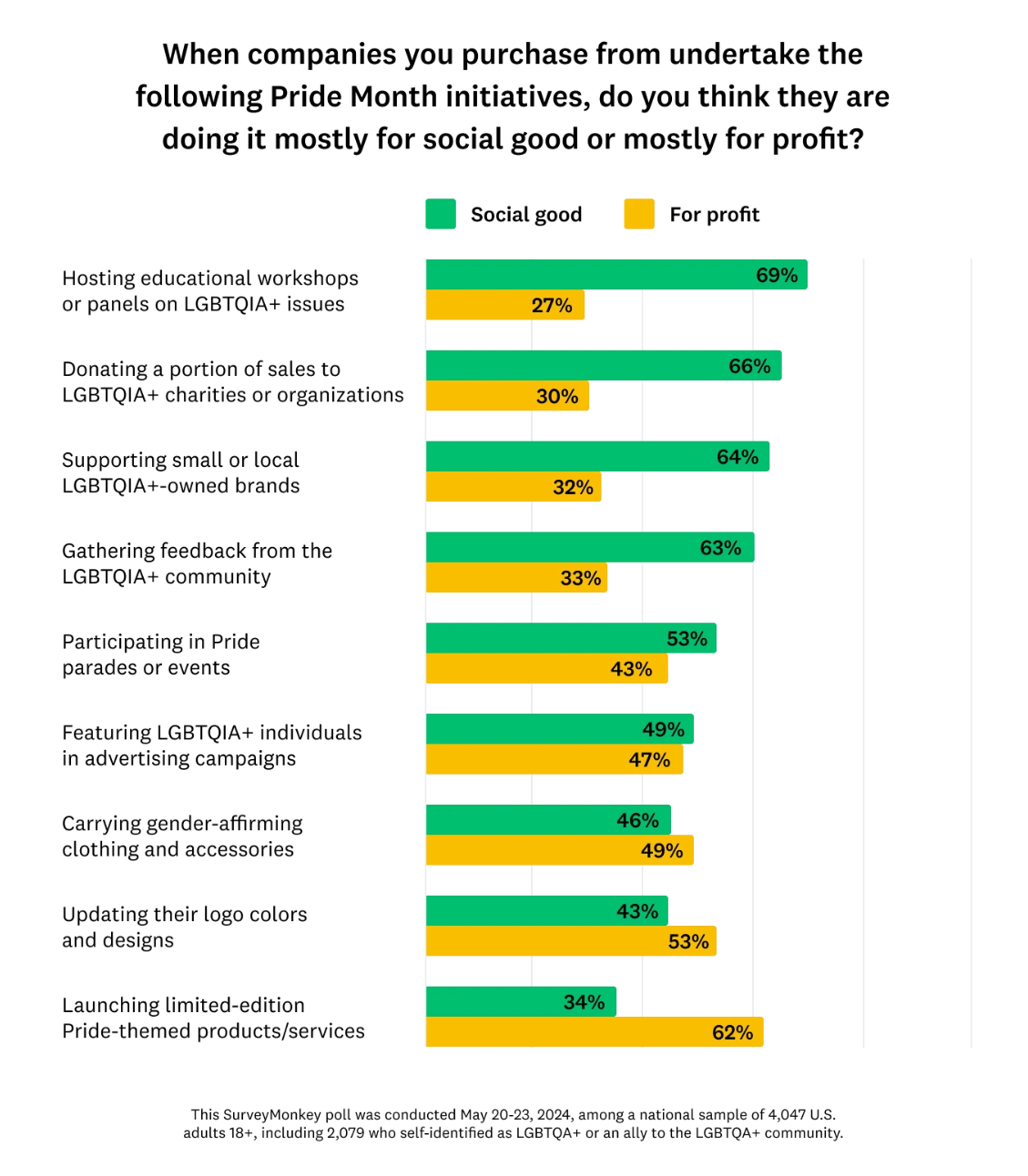
To be taken seriously, Pride campaigns need to be part of long-term support, not seasonal visibility.
However, recent data highlights a growing gap between what companies do during Pride Month and what the LGBTQIA+ community and its allies expect.
Here are key takeaways from SurveyMonkey’s poll:
- 64% of LGBTQIA+ individuals and allies believe most Pride campaigns are performative.
- 71% expect companies to be transparent about their Pride initiatives.
- 29% call rainbow-washing one of the worst things a brand can do during Pride.
- 69% say hosting educational panels or workshops on LGBTQIA+ topics feels genuinely supportive.
- 41% are more likely to support brands that show year-round commitment to LGBTQIA+ inclusion, not just in June.
- 30% say they research a brand’s LGBTQIA+ policies before making a purchase, which rises to 49% among those who buy Pride merchandise.
These expectations have raised the bar. As a result, audiences want more than visibility. They demand consistency, transparency, and real advocacy. And when those expectations aren’t met, skepticism grows.
That disconnect may explain why Pride Month marketing is noticeably quieter this year.
Why Is Pride Month Marketing Quieter This Year?
While some brands are scaling back their visibility, others have chosen not to promote Pride-related content at all.
This shift reflects lessons from last year, when backlash, political pressure, and consumer skepticism prompted many companies to rethink their approach.
Increased scrutiny around “rainbow-washing”
One of the main reasons why Pride Month marketing is losing traction is that many brands have faced criticism for rainbow-washing. The term refers to using Pride Month for visibility without demonstrating long-term support for LGBTQIA+ communities.
Consumers and creators have become more vocal in calling out campaigns that appear performative or disconnected from real impact.
In 2024, several brands like ‘The Phluid Project’ saw a drop (25%) in brand partnerships compared to previous years.
According to Inc., the founder and CEO, Rob Smith, tried to explain this phenomenon by mentioning that retailers decided to “play it safe” due to the elections and changes that the new administration enforced (e.g., new passport policy).
Some advocacy organizations like GLSEN, which helps businesses create inclusive messages, also reported declining corporate involvement and financial support tied to Pride campaigns.
However, the lack of involvement isn’t the only reason why Pride Month marketing has taken a hit.
Risk of backlash and boycotts
After facing backlash in 2023, brands like Target and Nike scaled back their Pride campaigns in 2024.
More specifically, Target reduced the number of stores featuring Pride merchandise, citing safety concerns after displays were disrupted the year before. Nike, which had offered Pride collections since 1999, opted out entirely in 2024, instead focusing on ongoing support programs.
Not all changes indicate complete withdrawal, though. While some companies stepped away, others are shifting toward sustained, year-round inclusion rather than seasonal visibility.
This shift raises an important question: Should every brand participate in Pride Month marketing or only those actively supporting the LGBTQIA+ community throughout the year?
Which Brands Should Participate in Pride Month Marketing?
While visibility matters, Pride Month should not be approached as a branding opportunity alone.
Campaigns that lack substance or internal backing can do more harm than good both to the brand and the community it claims to support.
Brands that show ongoing commitment
Brands that have demonstrated consistent support for the LGBTQIA+ community through hiring practices, internal policies, and community partnerships can easily run a more dedicated campaign during Pride Month.
Levi’s, for example, has been an active supporter since 1992.
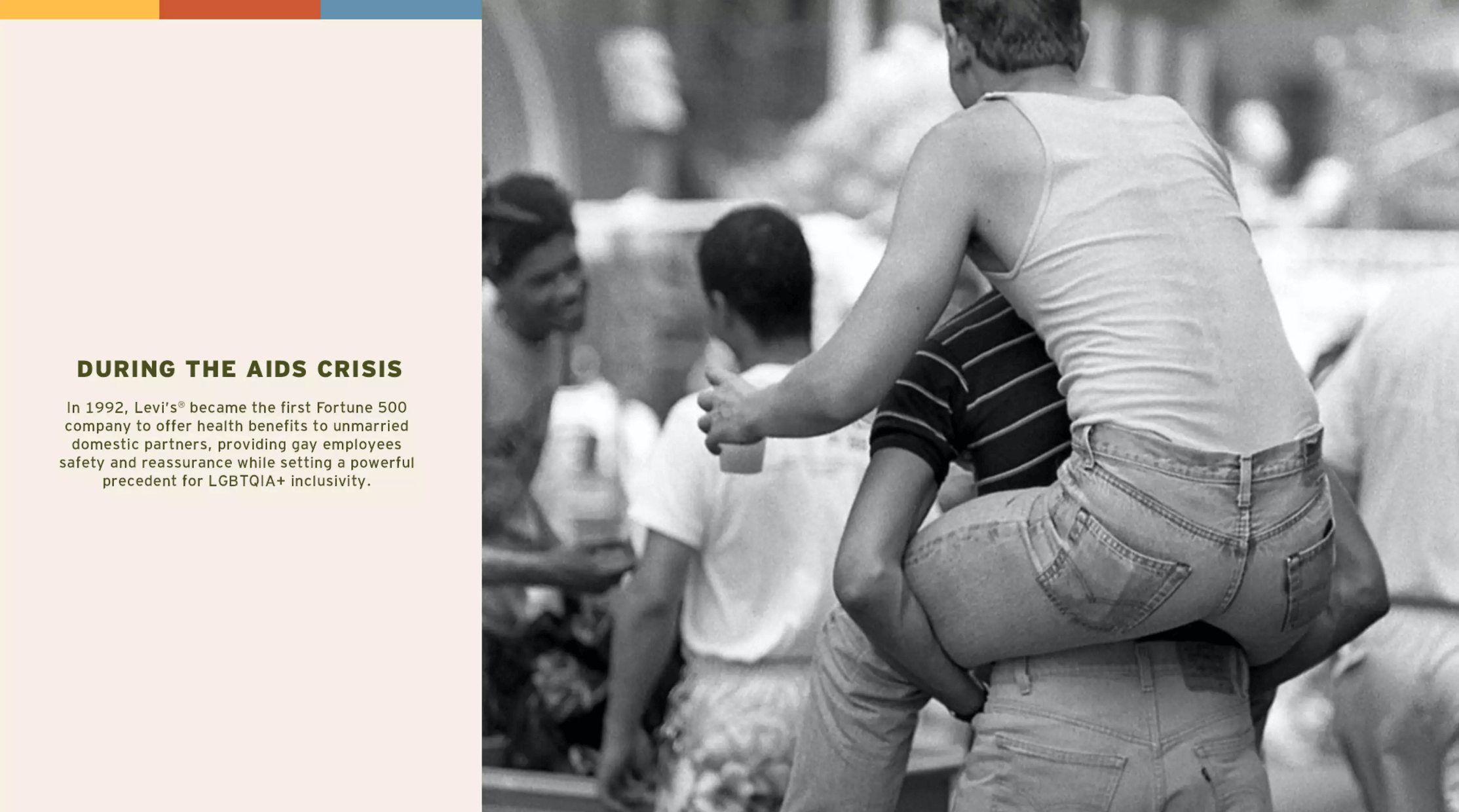
Their Pride campaigns feel like more of an extension of that commitment and ongoing efforts rather than following marketing trends and chasing the seasonality hype.
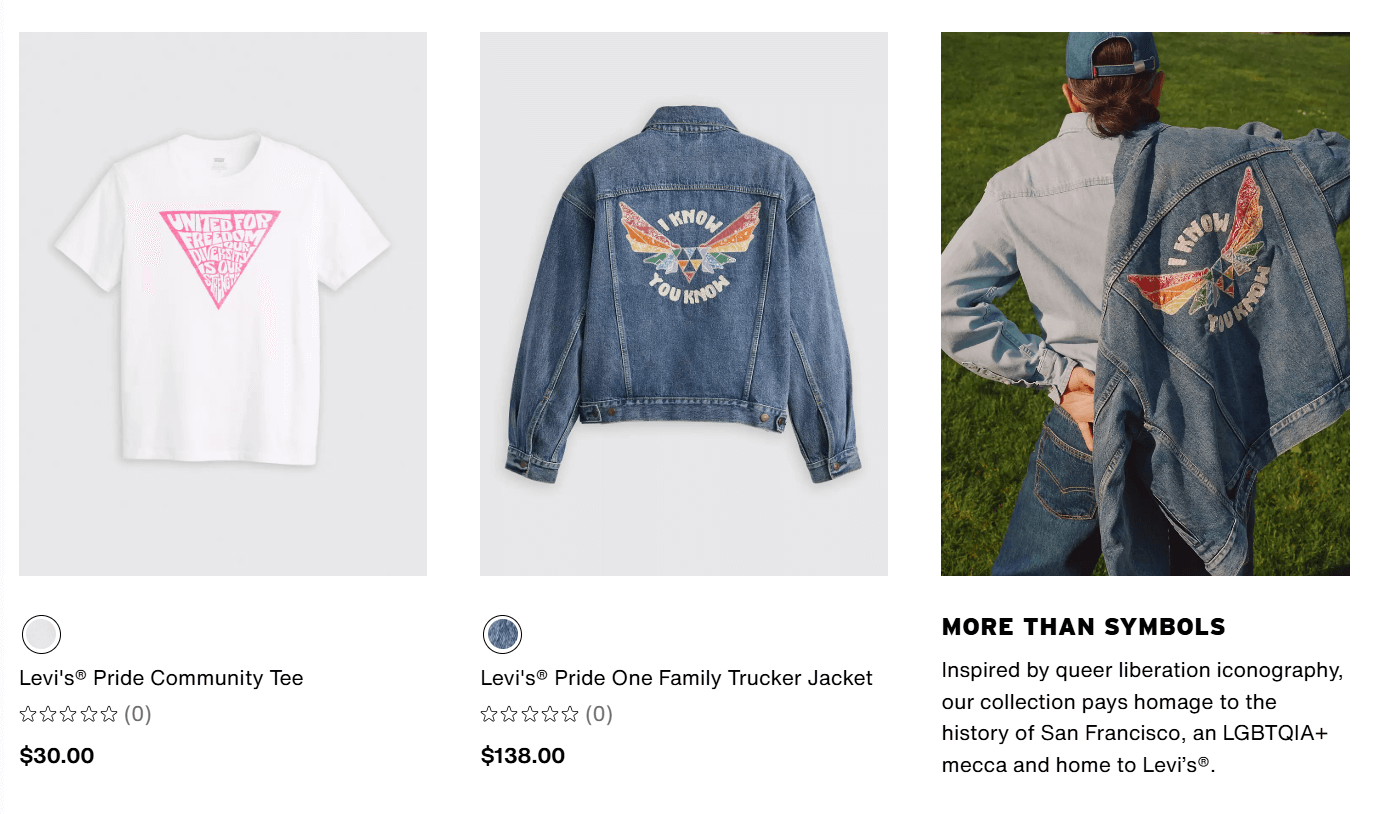
Brands that want to get involved long-term
Brands that are new to LGBTQIA+ advocacy can still take part, but they should begin with transparency.
If support is recent, that should be acknowledged, and plans for long-term action should be clear. Pride campaigns can serve as a starting poin,t but only if they come with real intent and follow-through.
To avoid backlash, plan your inclusion efforts well in advance and use Pride Month to share progress, not just promises.
Brands that aren’t ready to commit should take a step back
If a company has no internal policies, partnerships, or diversity initiatives related to LGBTQIA+ inclusion, launching a Pride campaign may backfire.
As you can see below, 40% believe that the worst mistake a brand could make in celebrating Pride is neglecting such policies.
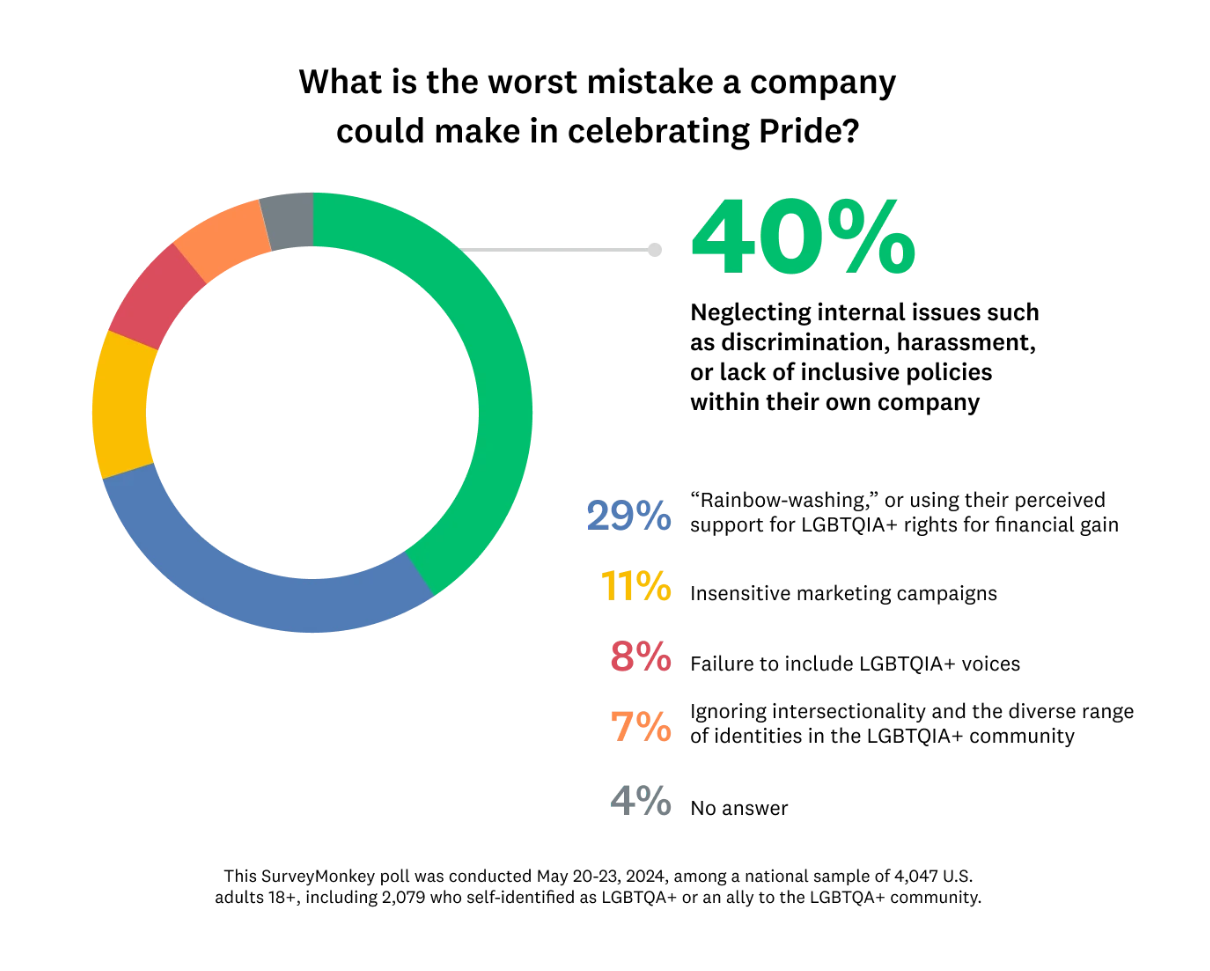
If your brand has yet to commit, stepping back is more responsible than sending a message that lacks support.
So, what about the brands that genuinely want to support Pride but are unsure how to do so respectfully?
How to Participate in Pride Month Without Being Performative
As mentioned above, Pride Month shouldn’t be treated as a seasonal branding opportunity because this leads to performative marketing.
To avoid that, be transparent across all channels, including email, social media, in-store, and web. Show that your brand’s support isn’t limited to June but part of a consistent, long-term commitment.
1. Update your logo if it supports real action
Changing a logo or product packaging with rainbow colors is common, but it shouldn’t be the whole campaign. If you choose to change your branding for Pride, it should come with context.
For example, tying the change to an initiative, such as donations to LGBTQIA+ nonprofits, support for queer-owned businesses, or employee-led events, will provide that.
Here’s what a popular brand like IKEA did:
- Participated in Pride events across the U.S., including the DC Capital Pride Parade
- Hosted an “Embrace Your Space” booth to welcome and celebrate attendees
- Donated $1 per rainbow cake sold (up to $100,000) to True Colors United to help end LGBTQIA+ youth homelessness
- Donated 100% of STORSTOMMA bag sales (up to $50,000) to Rainbow Railroad, supporting LGBTQIA+ individuals facing persecution

With actions like these, IKEA has more than enough reasons to update its logo for Pride. The difference is they didn’t, and that’s the point.
When a brand backs its words with real impact, it doesn’t need to rely on a temporary logo swap to prove anything. A visual change without substance risks being seen as rainbow-washing. But substance without spectacle? That speaks for itself.
If your brand is doing the work, show it through your actions. You don’t have to follow every trend to make your support visible, especially when your commitment is already clear.
2. Spotlight LGBTQIA+ employees, partners, or customers
Highlighting LGBTQIA+ members is one of the most direct ways to give visibility to the community.
This can be done through dedicated email marketing campaigns, social media takeovers, blog interviews, or short videos. Stories should be shared with consent and without editing out the actual experiences.
Also, avoid turning these stories into emotional appeals or marketing hooks. Let them be part of a broader effort to recognize LGBTQIA+ voices year-round.
Here’s a good example from Bobbi Brown’s Pride Month campaign, spotlighting friends in the LGBTQIA+ community, including their own Executive Director.
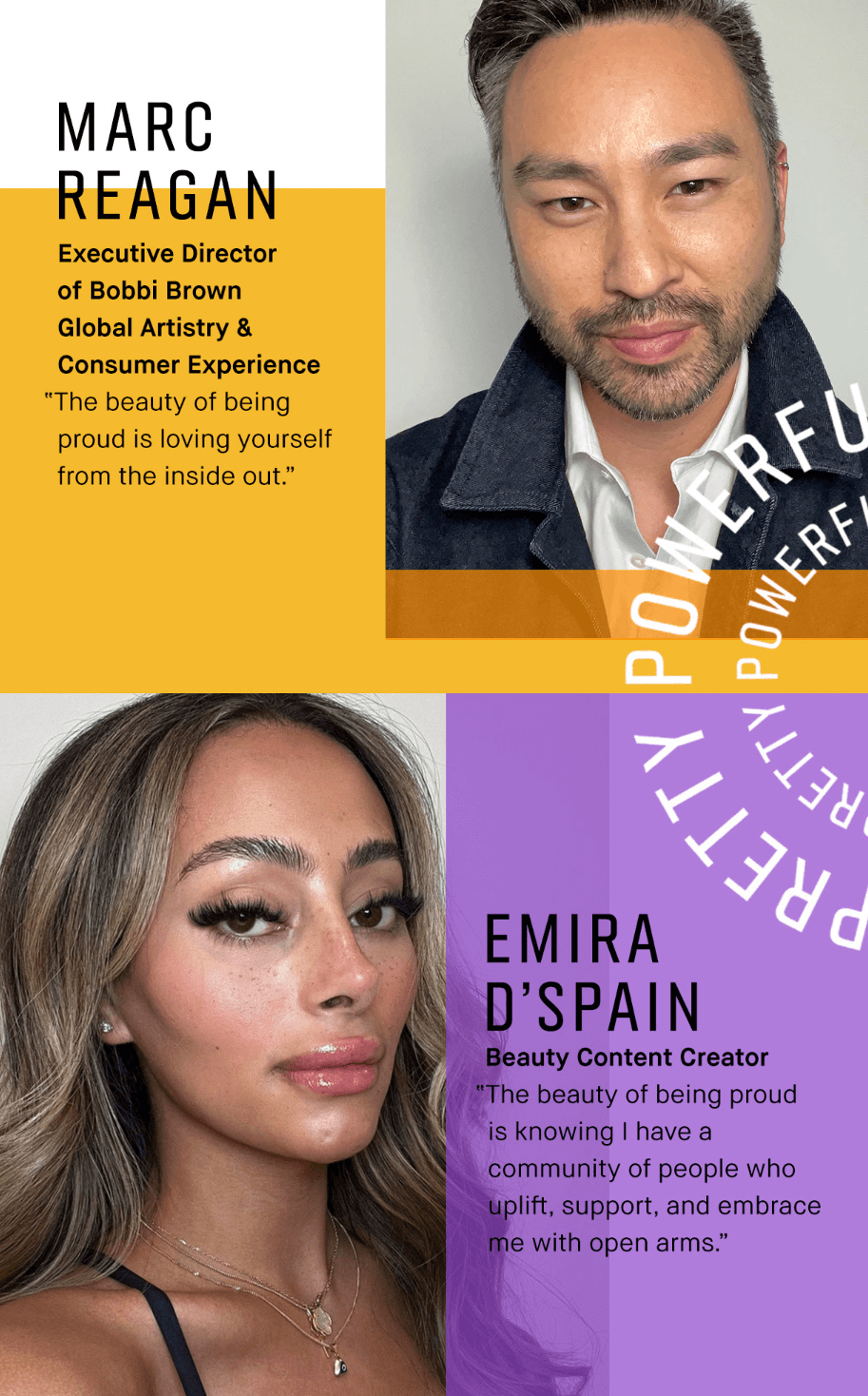
To do this yourself:
- Start by asking your LGBTQIA+ employees, creators, or partners if they want to be featured.
- Use simple Q&A formats, quotes, or short videos.
- Let them speak about what Pride means to them, in their own words.
- Publish across your main channels and link to actions your brand is taking so the story has context and purpose.
3. Prioritize impact over promotion
If you’re launching a Pride collection, make the purpose clear. Who benefits? How is the community involved? Products without a clear goal or contribution often feel performative.
Happy Socks is a good example of how to approach this the right way.
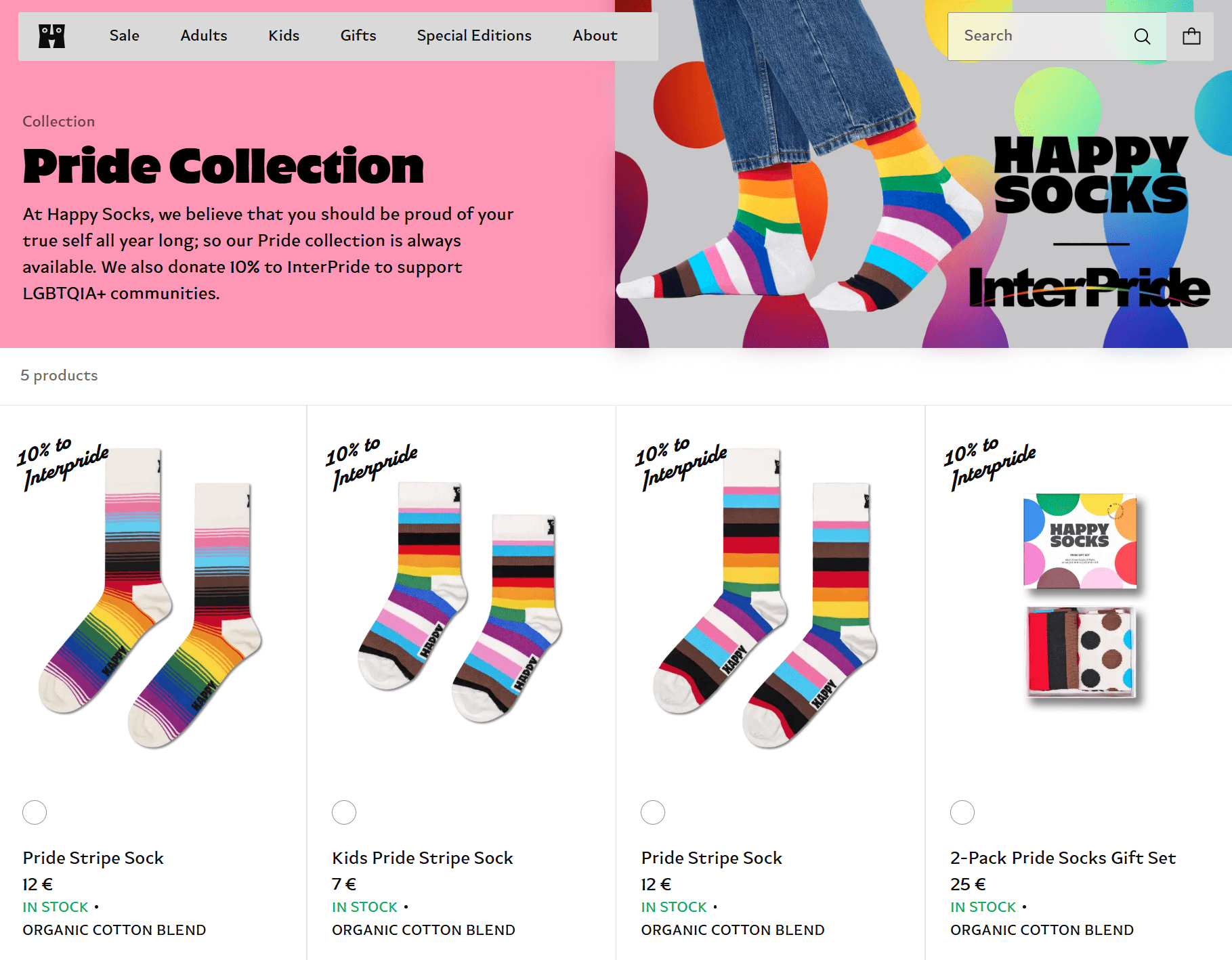
Their Pride collection is available year-round, not just in June. They also donate 10% of proceeds to InterPride, a global organization supporting LGBTQIA+ communities. The campaign centers on inclusion and long-term visibility, favoring impact over seasonal promotion.
When brands are transparent about where funds go and why the initiative matters, it shows intent.
4. Distribute valuable content through email
Email is a direct way to communicate your Pride Month efforts, but it needs to go beyond product promotion.
To avoid performative messaging, use email to show your actions and community involvement.
Here’s a good example from MeUndies.
Subject line: We 💜 LA LGBT Center
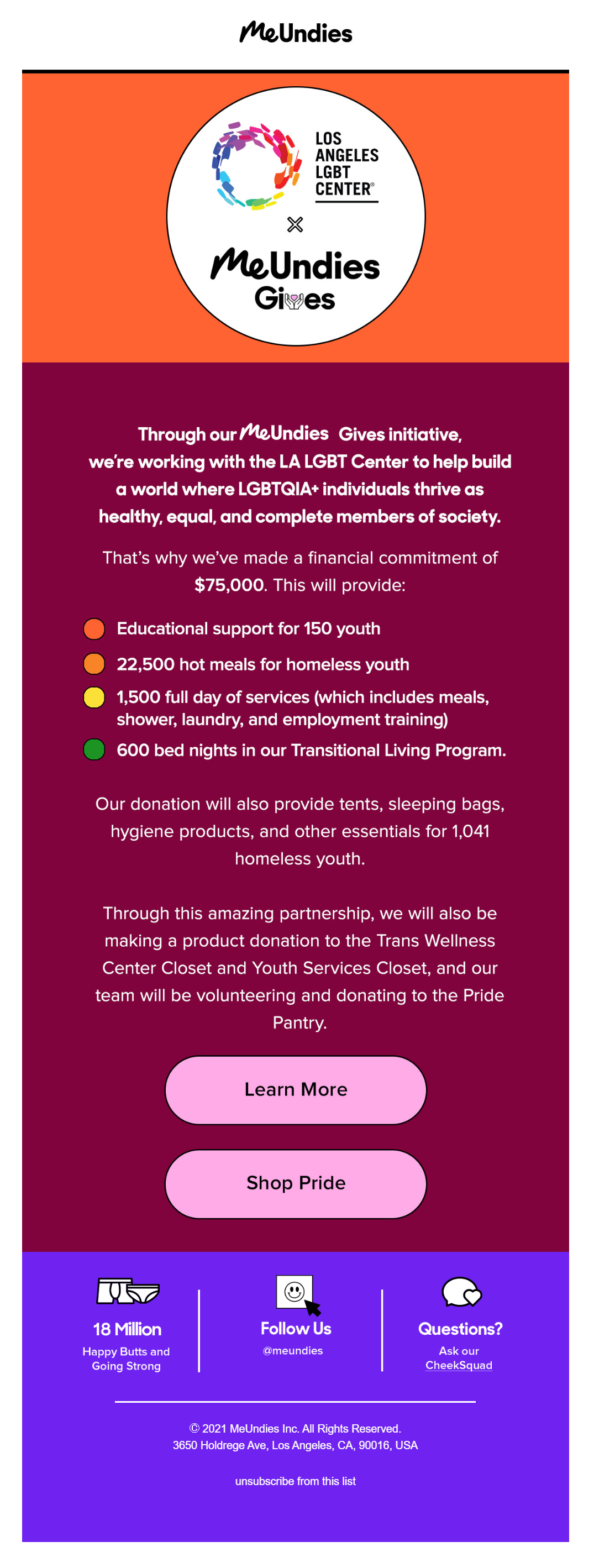
In their Pride Month email marketing campaign, they clearly outline their $75,000 donation to the LA LGBT Center and break down how the funds will be used, from educational support and meals to transitional housing for homeless LGBTQIA+ youth.
The email includes specific numbers, details, and follow-through actions like product donations and team volunteering. It’s clear, measurable, and shows the impact.
For your brand, use email marketing to:
- Explain your campaign’s purpose and who benefits
- Share real partnerships and internal initiatives
- Include direct links to resources or donation pages
- Follow up later with impact metrics or community feedback
Avoid vague phrases like “we stand with the LGBTQIA+ community” unless you can show how.
The more specific you are, the more trustworthy your message becomes.
5. Use social media to show your actions
Social media is often the most visible part of a Pride campaign, but it’s also where performative marketing is easiest to spot.
To be respectful, brands should use their platforms to educate, amplify, and share actions.
Accenture’s 2024 Pride video is a great example of how to do it.
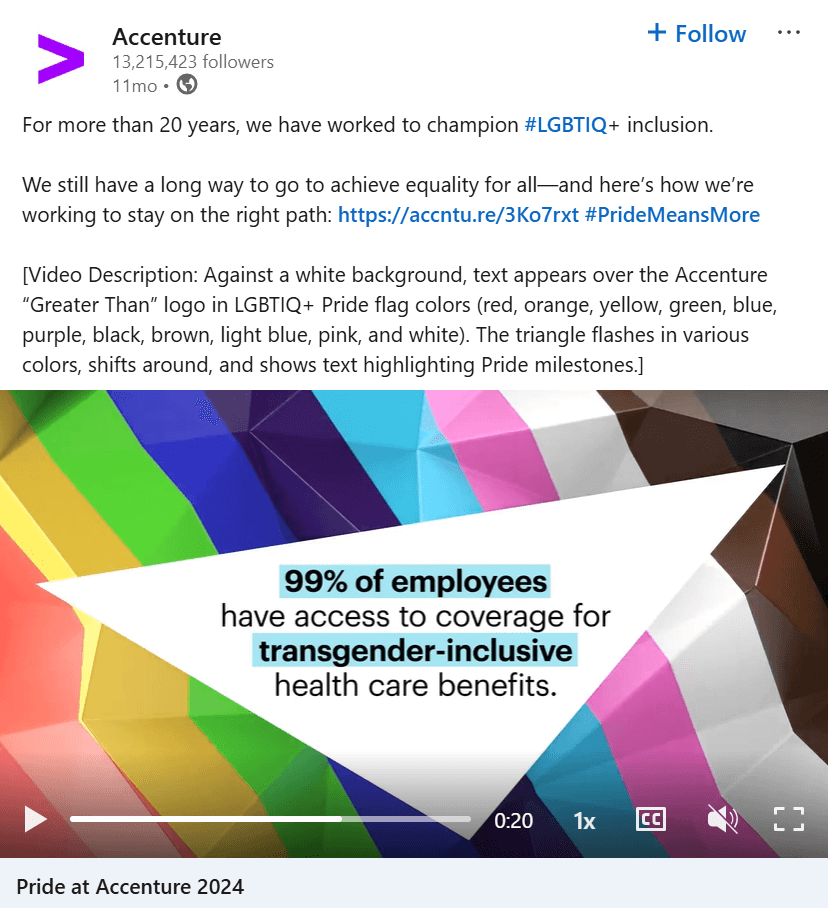
Instead of promoting products, the company highlights some important actions, including the fact that 99% of employees have access to transgender-inclusive health care.
The campaign shows what inclusion looks like through facts, not slogans. That’s the kind of content that earns trust.
6. Feature LGBTQIA+ brands and creators
As mentioned, respectful Pride Month marketing doesn’t need to rely on rainbows to be effective. Instead of filling shelves or banners with symbolic colors alone, focus on substance.
Use your in-store displays or homepage to spotlight products created by LGBTQIA+ artists or businesses. Share their stories, not just their designs. Highlight their role in shaping the collection and explain why your brand collaborated with them.
This not only promotes real voices but shifts the focus from decoration to meaningful participation.
Now, let’s examine Target’s infamous 2023 Pride campaign. The backlash didn’t come from featuring LGBTQIA+ creators but from how the campaign was handled.

Overly broad, heavily branded displays lacked nuance and drew unnecessary attention from extremist groups. Worse, employees were left without clear support when controversy arose.
Instead of plastering rainbows across products, Target could have taken a more thoughtful approach, uplifting small LGBTQIA+-owned brands, highlighting individual creators, and scaling visibility based on context.
If there’s a lesson to be learned here, it’s that Pride doesn’t require mass-produced (rainbow-colored) merchandise.
Pride Month Marketing Campaign Examples: The Good & the Problematic
Some brands have delivered Pride campaigns that are thoughtful, authentic, and deeply aligned with their values.
Others, however, have missed the mark, falling into performative gestures or disconnected messaging.
Let’s take a closer look to help you avoid common pitfalls in the future.
Freeletics’ successful LGBTQIA+ spotlight
This campaign by Freeletics is a great example of how to use storytelling, representation, and purpose-driven content to meaningfully support Pride Month.
Subject line: Outrunning stereotypes

Let’s see what works:
- Focus on storytelling over sales: The email centers on Anthony, an LGBTQIA+ athlete and coach, sharing his personal journey. The message is authentic, inspiring, and free of sales-heavy language.
- Real representation: Instead of rainbow graphics or generic statements, the campaign highlights real experience. Quotes and photos put a face to the message of inclusion in fitness.
- Purpose-led content: The CTA buttons align with the broader theme of empowerment, without pushing a discount or limited-time offer. It connects product to purpose.
- Thoughtful design: The email uses clean visuals, inclusive language, and a minimal Pride-themed banner (Flex your pride) without overwhelming the story.
- Clear internal alignment: Highlighting an LGBTQIA+ team member in a feature story signals internal support, not just outward-facing branding.
Why it’s a good Pride Month campaign:
It avoids rainbow-washing by showing real people, elevating authentic stories, and using Pride Month to reinforce the brand’s values around inclusion, performance, and representation. There’s no forced tone shift, and the campaign would still feel credible even outside of June.
Lego’s “Everyone is Awesome”
LEGO’s “Everyone is Awesome” campaign is a powerful example of how a brand can merge product, storytelling, and internal values into one cohesive Pride initiative, without performative overtones.
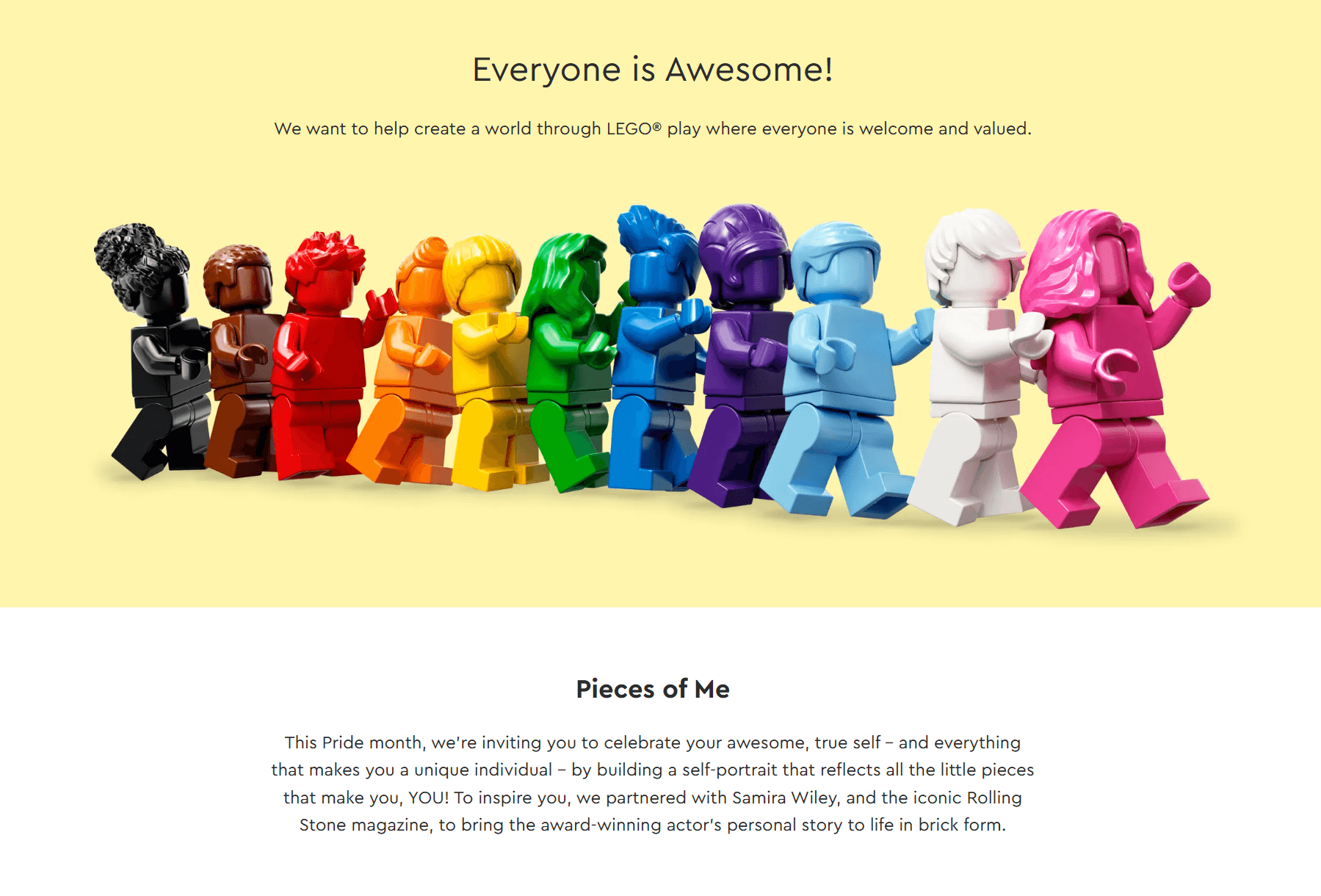
Here’s why it worked:
- Designed by and for the LGBTQIA+ community: The set was conceived and designed by LEGO’s Vice President of Design, Matthew Ashton, who is openly gay. His personal story powers the product, giving it authenticity from the inside out.
- Focused on self-expression: The product, while commercial, isn’t just merchandise. Ashton shares how a set like this would have meant everything during his own coming out, changing the narrative from product to purpose.
- Representation with intention: The minifigures represent the full spectrum of the LGBTQIA+ community, including Black, Brown, and trans individuals. The inclusion of a purple drag queen figure also celebrates queer culture in a respectful way.
- Emotional storytelling: Ashton speaks openly about growing up in the 80s, facing pressure to conform, and how this project became both a personal milestone and a signal of support to others. It’s a heartfelt message, not a marketing script.
- Internal alignment and allyship: This initiative wasn’t created in isolation and reflects LEGO’s broader commitment to inclusion.
Why it’s a good Pride Month campaign:
LEGO’s example showed what Pride marketing should be: inclusive by design and focused on community. It doesn’t just say “Everyone is awesome.” It shows us why and how that belief is lived out in practice.
Skittles & GLAAD: “When You Find Your Community, Your Colors Shine”
Skittles has become a recognizable presence in Pride Month marketing over the past five years, not through flashy campaigns, but by consistently evolving how they show up for the LGBTQIA+ community.
Their Pride campaign built on that legacy with a deeply community-oriented approach.
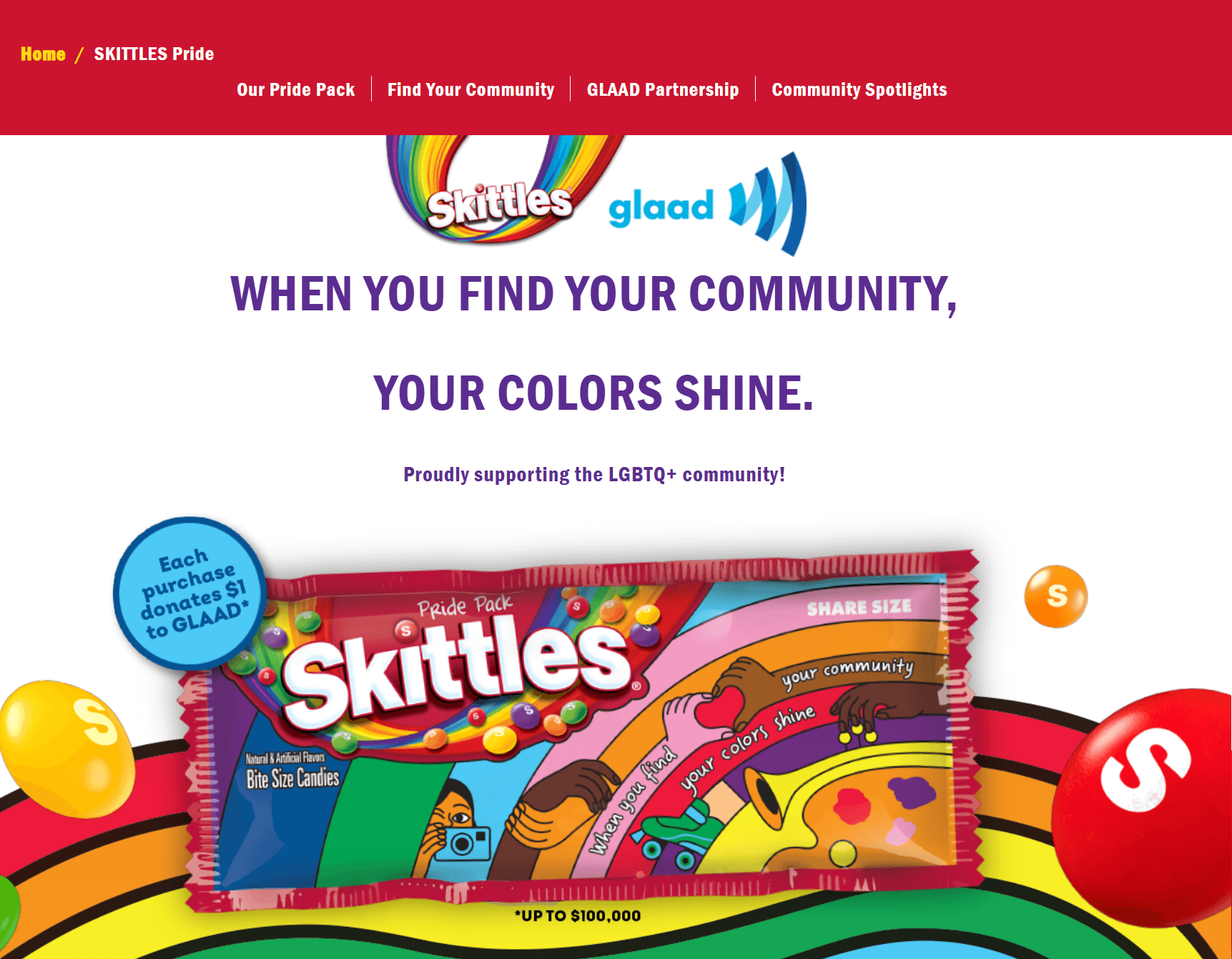
Let’s see what worked:
- Ongoing commitment: Skittles has partnered with GLAAD for five years, showing long-term support beyond just Pride Month. Their messaging stays visible year-round.
- Transparent impact: $1 from every Pride Pack (up to $100K) goes to GLAAD, plus $25K in donation matching. The brand is clear about where the money goes.
- Community first: Instead of just branding, Skittles funds LGBTQIA+ groups across the U.S., supporting everything from roller derby teams to queer film festivals.
- Purposeful packaging: From their iconic grey packs to current custom art by queer creators, Skittles uses packaging to shift focus from candy to community.
- Identity over aesthetic: The tagline “When you find your community, your colors shine” reframes the rainbow’s use as personal expression, not a marketing symbol.
Why it’s a good Pride Month campaign:
Skittles doesn’t just show up during Pride Month. Through product design, sustained donations, and localized impact, they’ve embedded support for the LGBTQIA+ community into their brand narrative. It’s bold, fun, and, most importantly, full of substance.
Now, let’s see some not-so-great campaigns and why they were met with criticism.
Bud Light’s & Dylan Mulvaney
In April 2023, Bud Light partnered with transgender influencer Dylan Mulvaney in a single sponsored post to celebrate her “365 Days of Girlhood.”
The campaign aimed to align the brand with Pride and broader inclusion efforts. Instead, it sparked one of the most significant and prolonged brand backlashes in recent marketing history.
What happened:
- Backlash began immediately after the post went live, largely fueled by conservative voices on social media. High-profile figures called for boycotts and publicly denounced the brand.
- Sales plummeted, with a 28% drop in purchase incidence across the U.S. in the first three months. In heavily Republican counties, the decline reached 32%.
- Unlike other short-lived boycotts, Bud Light’s sales remained down by 32% into Q4 2023.
Why it missed the mark:
- No internal support: The campaign was limited to a single social post, with no broader message or visible support when backlash hit. Bud Light stayed silent instead of standing by its partner.
- No long-term inclusion strategy: There were no prior or follow-up LGBTQIA+ collaborations. Without consistency, the effort felt opportunistic rather than genuine.
- Retreat under pressure: Anheuser-Busch ended its 30-year sponsorship of Pride St. Louis, leaving organizers with a $150,000 funding gap.
- Ongoing visibility loss: Retailers cut Bud Light shelf space, further lowering sales and visibility and trapping the brand in a long-term decline.
Bud Light’s campaign wasn’t flawed because it supported a trans influencer. It failed because it lacked preparation, consistency, and commitment.
Burger King’s “Pride Whopper”
While “Pride Whopper” began as an attempt to support the LGBTQIA+ community during Pride Month, it has since become one of Burger King’s most criticized campaigns.
While the brand partnered with advocacy groups and included a donation pledge, the execution fell flat, resulting in backlash from the very audience it intended to support.

Why it missed the mark:
- Poor creative judgment: Serving the Whopper with “two top buns or two bottom buns” was meant to be symbolic but came off as tone-deaf, reducing LGBTQIA+ identity to a clumsy pun.
- Perceived rainbow-washing: With no visible history of LGBTQIA+ support, the campaign felt more like a marketing ploy than real advocacy.
- No internal alignment: Burger King offered no updates on inclusion policies or employee support, only a temporary product and vague messaging.
- No community consultation: The agency responsible for the campaign admitted they didn’t involve LGBTQIA+ voices during development, underlining the lack of meaningful collaboration.
- Poor response to backlash: Rather than take accountability, Burger King deleted content and stayed silent. The only apology came from the agency, not the brand.
Email Marketing for Pride Month
Unlike social media and offline marketing, emails allow space to share meaningful context, explain your actions clearly, and reach people who have already chosen to hear from you.
Done right, email can educate, inform, and promote, without being performative. Let’s see what you need to know about Pride Month email marketing below.
Actionable tips for a good Pride Month email
Creating a good email for Pride Month shouldn’t be a problem if you’re already familiar with email marketing best practices.
You must adapt them to reflect care, clarity, and genuine intent to make it work.
- Write respectful subject lines: Avoid clickbait or using Pride purely for open-rate boosts. Instead, keep your subject lines direct and value-driven. For example, “Pride Is More Than a Month: Here’s What We’re Doing” will be more considerate than “20% off Pride Month.”
- Use inclusive copy: State what you’re doing, who you’re supporting, and why it matters. Use inclusive email copy and avoid stereotypes or vague statements. For example, share real stories and let LGBTQIA+ employees, partners, or collaborators speak through quotes or spotlights.
- Don’t rainbow-wash your design: Design your Pride emails with intention. Use Pride colors meaningfully, not decoratively. Prioritize accessibility with clear contrast and alt text.
- Add contextual CTAs: Link CTAs to impact-focused content like donations, education, or campaign results, not only product pages.
- Keep your messaging aligned: Your messages must align with your brand voice and be tied to real actions. Avoid tone shifts that feel forced or disconnected from your usual communication style.
- Be mindful of email frequency: Send one to three emails during Pride Month: a kickoff, a mid-month update, and a final results email. Don’t over-send and prioritize relevance over volume to maintain trust and engagement.
Lastly, not every subscriber may want to receive content related to Pride. Respect this by including an opt-out link in your emails or a preferences center, allowing subscribers to control what messages they receive.
This shows consideration and protects trust.
Further reading: Check out our June email marketing planner to learn how to structure your LGBTQIA+ month campaign properly.
Pride Month newsletter templates
A well-designed email template can help you launch your Pride campaign quickly and with better design control.
It also ensures your emails look polished across devices and reduces the chance of design errors.
Moosend offers ready-to-use templates that you can fully customize with your brand’s messaging, visuals, and tone. These give you a strong starting point while keeping your campaign aligned and professional.
True colors newsletter design
This Pride Month template uses a clean, structured layout that balances visuals and copy.
It opens with a bold announcement bar, followed by a centered headline in large type for immediate impact. The copy blocks are placed just below the header to highlight the offer.
The call-to-action button is also large and prominent, making it easy to navigate. The footer includes clear social links and an unsubscribe option, making customization easy while maintaining accessibility and mobile responsiveness.
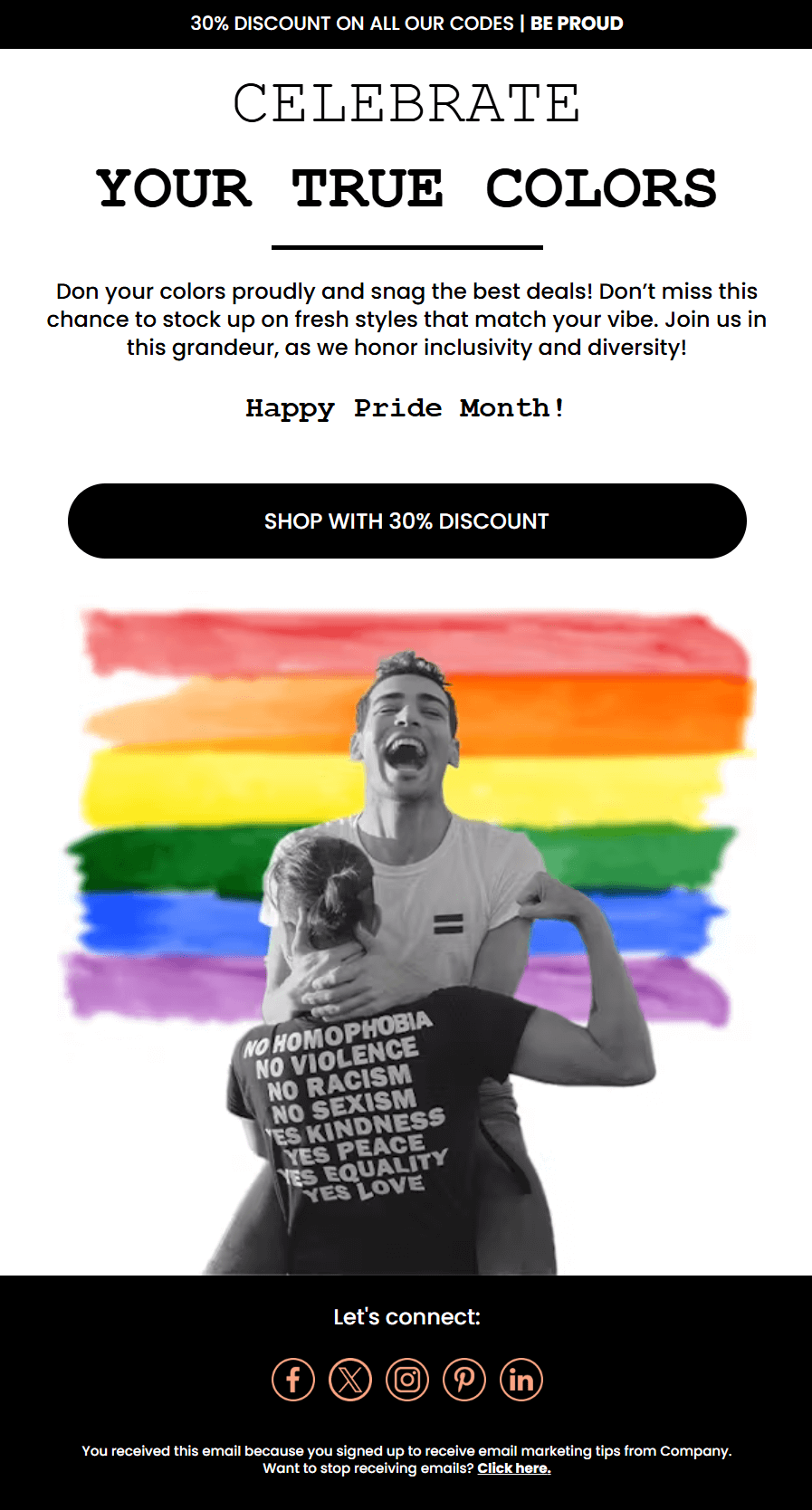
For a more engaging campaign, add a donation link, a note about where proceeds go, or a brief statement of support.
Subject line ideas to use:
- Pride with Purpose: See How We’re Giving Back
- Celebrating Pride Month, Backed by Action
- Our Pride, Our Commitment, Beyond Just a Logo
- This Month, Every Color Counts
Inner rainbow newsletter template
This template is perfect for beauty brands looking to highlight colorful products.
The layout has clear sections featuring vibrant visuals and simple descriptions, each supported by a bold CTA button. The mid-section introduces a spotlight product, and the email wraps up with a photo collage for visual impact.
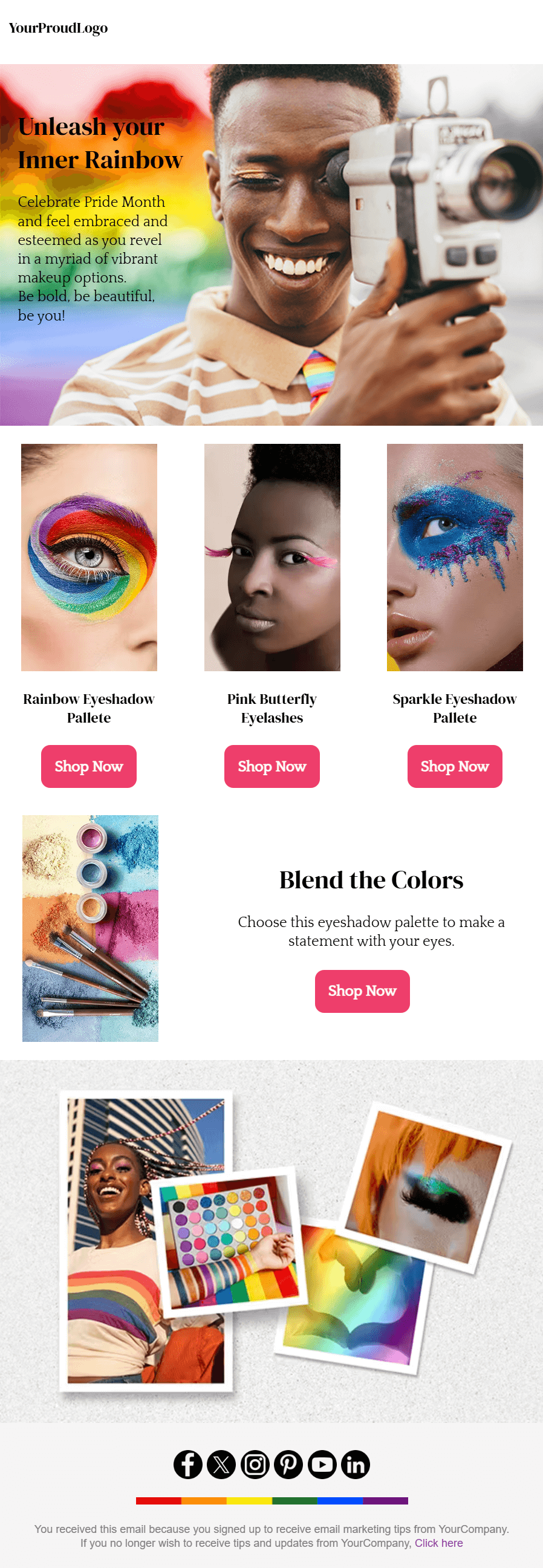
To avoid performative marketing, brands should pair this format with action highlights or quotes.
Email content ideas:
- Include a short bio or quote from an LGBTQIA+ artist, model, or collaborator featured in the campaign.
- Add a short section or link to a blog post or video showing how the campaign was created, especially if LGBTQIA+ talent helped shape it.
- Insert a testimonial or social photo from a real customer expressing themselves with your products during Pride Month.
- Offer a link to an LGBTQIA+ advocacy organization or educational content related to Pride.
Rainbow for all newsletter design
This Pride-themed template is vibrant and visually engaging, structured around bold colors and playful product highlights.
The header introduces the theme with a welcoming title and a short paragraph encouraging self-expression and authenticity. Each product section features styled imagery paired with a quick description and color-coded CTA buttons like “Pick a Hue,” leading the reader through a visually guided journey.

Consider modifying the CTA and copy to reflect purpose-driven messaging for a more respectful and balanced approach.
CTA suggestions for impactful campaigns:
- See Who Made This
- Support LGBTQIA+ Creators
- Shop With Purpose
- See the Story Behind the Style
- Gifts That Give Back
- Shop Inclusive Essentials
For more, take a look at our Seasonal email designs and Nonprofit email templates.
Pride Marketing Do’s and Don’ts
Now that we’ve explored how to run a meaningful Pride campaign, let’s summarize the essential dos and don’ts to help you avoid common missteps.
Do’s
- Reflect internal values in external messaging.
- Support with donations, partnerships, and volunteer efforts.
- Involve LGBTQIA+ voices in your content and planning.
- Be transparent about the impact and where the support goes.
- Share year-round efforts, not just June visibility.
- Maintain inclusive policies and safe environments.
Don’ts
- Don’t launch campaigns without internal backing.
- Don’t use identities for aesthetics or sales only.
- Don’t ignore backlash, but address it with accountability.
- Don’t go silent after Pride Month ends.
- Don’t rainbow-wash with no substance behind it.
Rethink Pride Month Marketing
Pride Month reminds us of the ongoing fight for visibility, equality, and acceptance. If your brand plans to participate, do so with purpose. If not, it’s better to step back.
LGBTQIA+ audiences and their allies are paying attention. And they don’t need more rainbow packaging or vague promises. They want real support, honest messaging, and actions that continue beyond June.
So, before you plan a campaign, ask yourself: Are we doing this because we care or because it’s profitable? If it’s the latter, you should find another way. Luckily, June offers numerous other opportunities to do so.
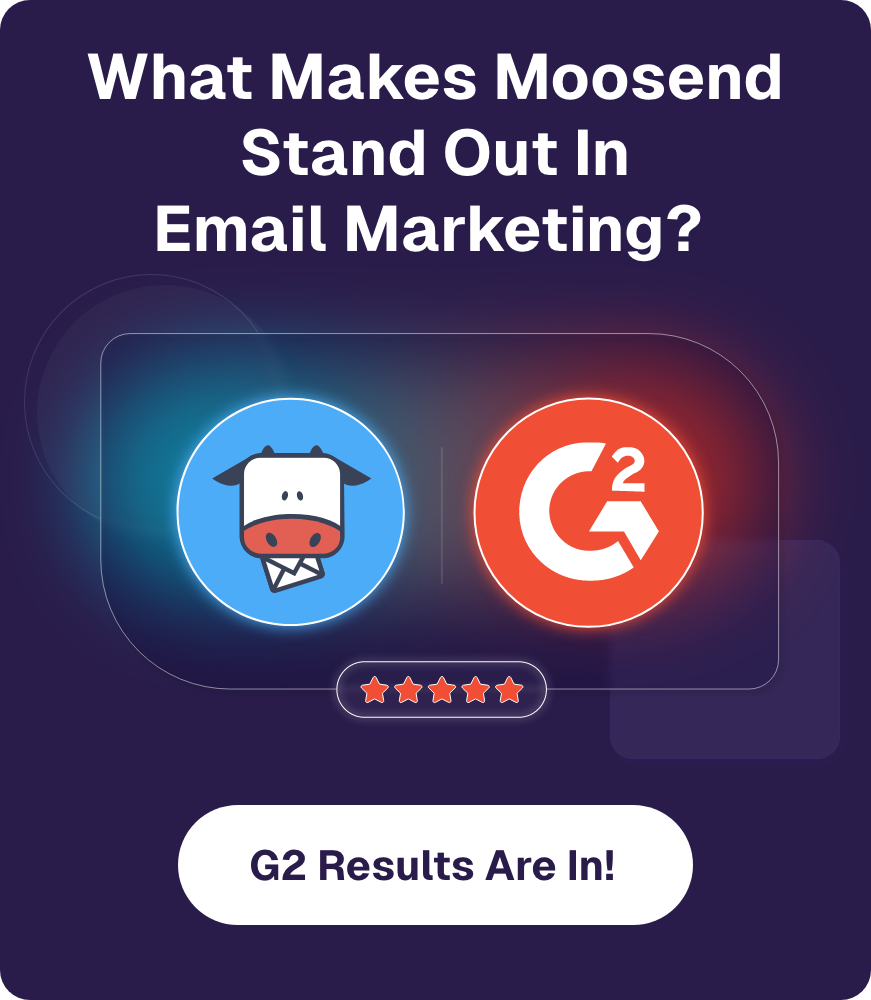
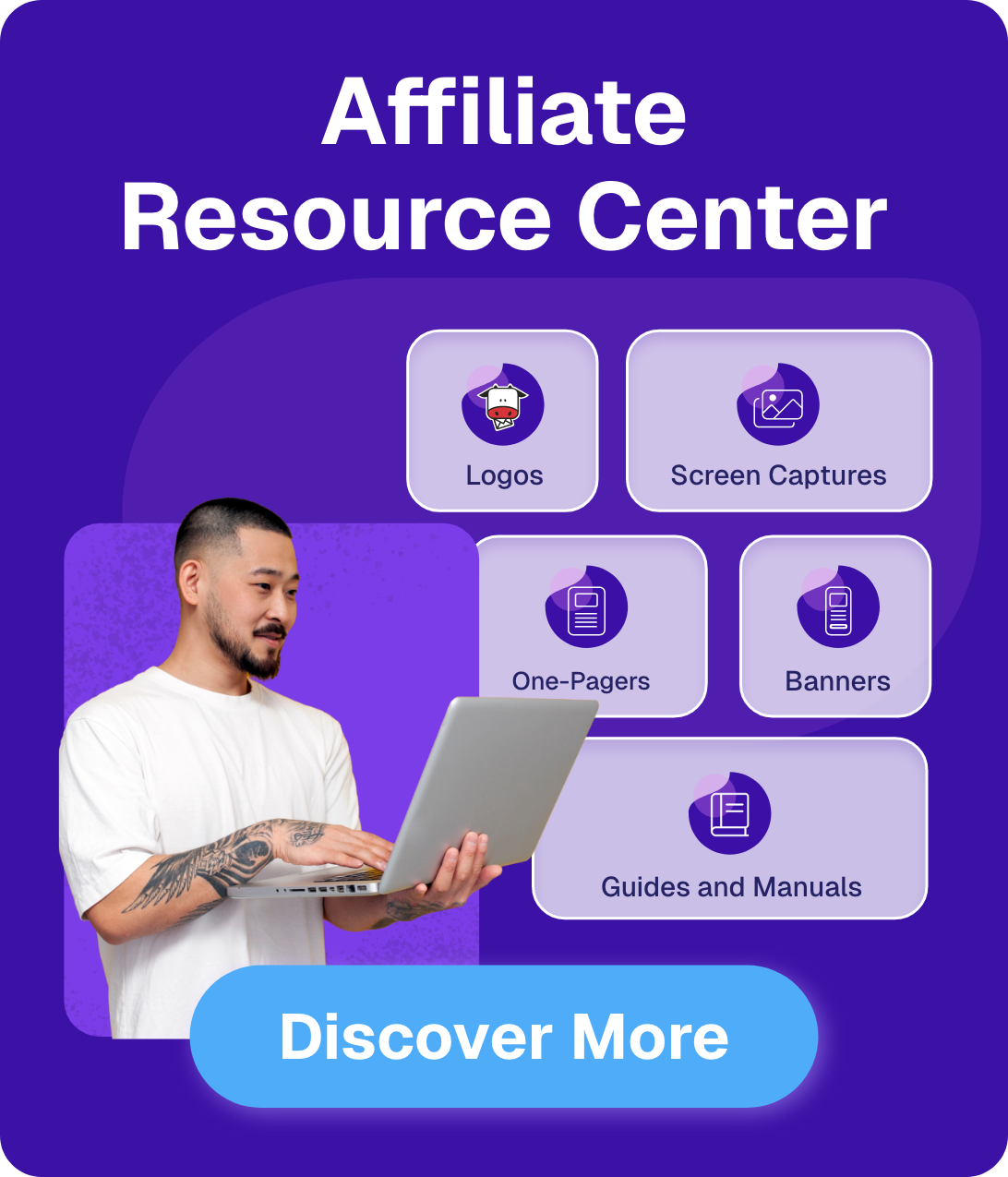


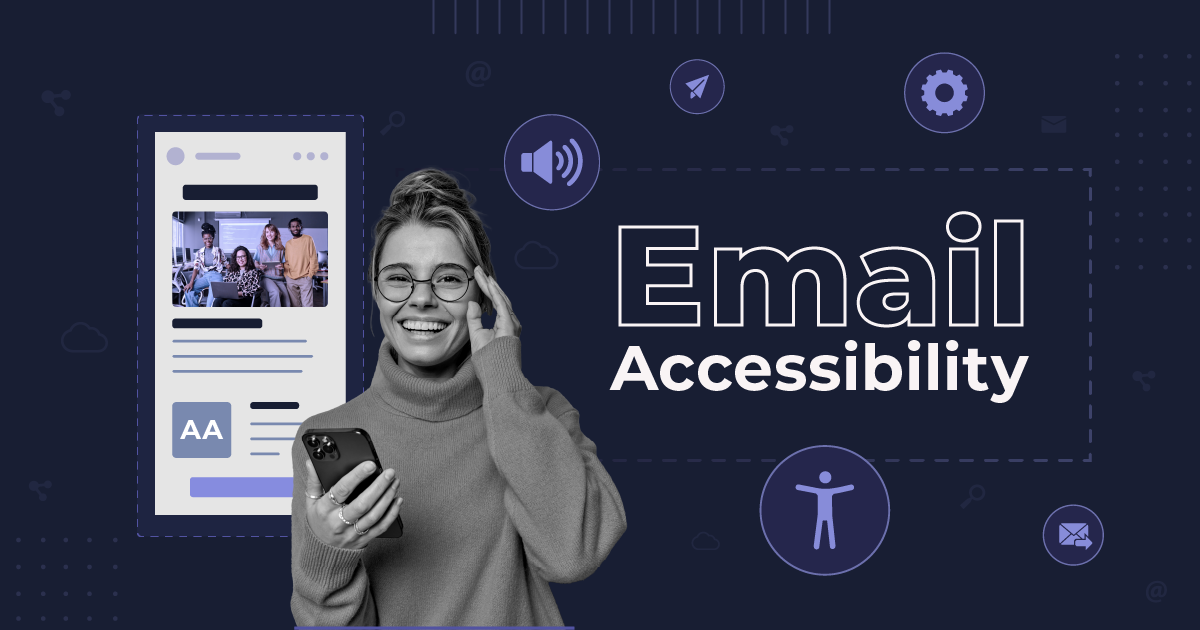
 Published by
Published by
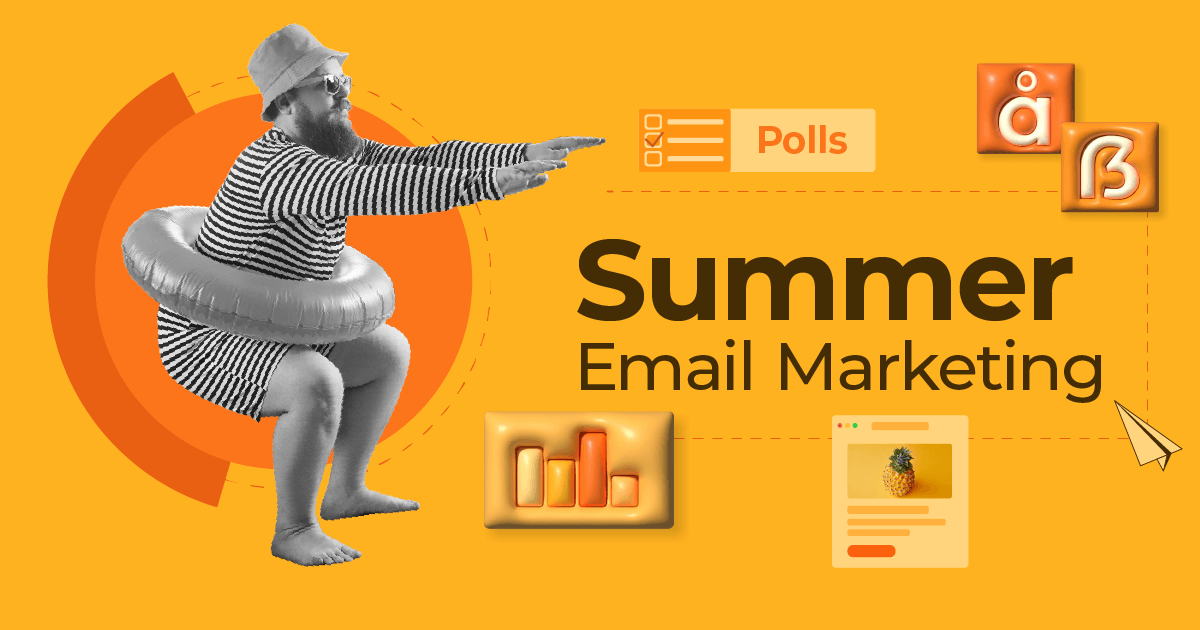
 Published by
Published by